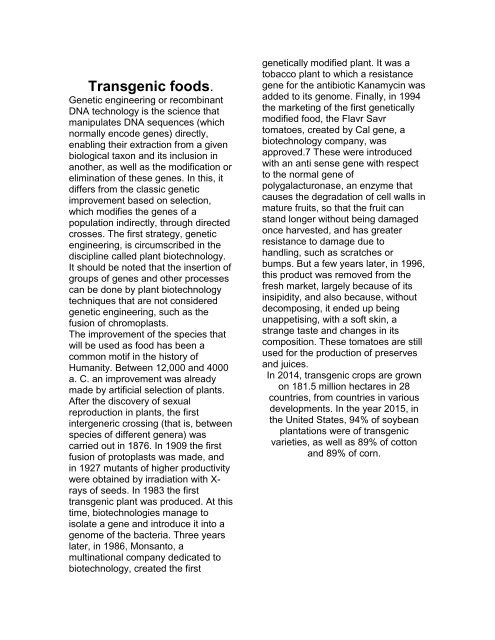You also want an ePaper? Increase the reach of your titles
YUMPU automatically turns print PDFs into web optimized ePapers that Google loves.
Transgenic foods.<br />
Genetic engineering or recombinant<br />
DNA technology is the science that<br />
manipulates DNA sequences (which<br />
normally encode genes) directly,<br />
enabling their extraction from a given<br />
biological taxon and its inclusion in<br />
another, as well as the modification or<br />
elimination of these genes. In this, it<br />
differs from the classic genetic<br />
improvement based on selection,<br />
which modifies the genes of a<br />
population indirectly, through directed<br />
crosses. The first strategy, genetic<br />
engineering, is circumscribed in the<br />
discipline called plant biotechnology.<br />
It should be noted that the insertion of<br />
groups of genes and other processes<br />
can be done by plant biotechnology<br />
techniques that are not considered<br />
genetic engineering, such as the<br />
fusion of chromoplasts.<br />
The improvement of the species that<br />
will be used as food has been a<br />
common motif in the history of<br />
Humanity. Between 12,000 and 4000<br />
a. C. an improvement was already<br />
made by artificial selection of plants.<br />
After the discovery of sexual<br />
reproduction in plants, the first<br />
intergeneric crossing (that is, between<br />
species of different genera) was<br />
carried out in 1876. In 1909 the first<br />
fusion of protoplasts was made, and<br />
in 1927 mutants of higher productivity<br />
were obtained by irradiation with X-<br />
rays of seeds. In 1983 the first<br />
transgenic plant was produced. At this<br />
time, biotechnologies manage to<br />
isolate a gene and introduce it into a<br />
genome of the bacteria. Three years<br />
later, in 1986, Monsanto, a<br />
multinational company dedicated to<br />
biotechnology, created the first<br />
genetically modified plant. It was a<br />
tobacco plant to which a resistance<br />
gene for the antibiotic Kanamycin was<br />
added to its genome. Finally, in 1994<br />
the marketing of the first genetically<br />
modified food, the Flavr Savr<br />
tomatoes, created by Cal gene, a<br />
biotechnology company, was<br />
approved.7 These were introduced<br />
with an anti sense gene with respect<br />
to the normal gene of<br />
polygalacturonase, an enzyme that<br />
causes the degradation of cell walls in<br />
mature fruits, so that the fruit can<br />
stand longer without being damaged<br />
once harvested, and has greater<br />
resistance to damage due to<br />
handling, such as scratches or<br />
bumps. But a few years later, in 1996,<br />
this product was removed from the<br />
fresh market, largely because of its<br />
insipidity, and also because, without<br />
decomposing, it ended up being<br />
unappetising, with a soft skin, a<br />
strange taste and changes in its<br />
composition. These tomatoes are still<br />
used for the production of preserves<br />
and juices.<br />
In 2014, transgenic crops are grown<br />
on 181.5 million hectares in 28<br />
countries, from countries in various<br />
developments. In the year 2015, in<br />
the United States, 94% of soybean<br />
plantations were of transgenic<br />
varieties, as well as 89% of cotton<br />
and 89% of corn.


